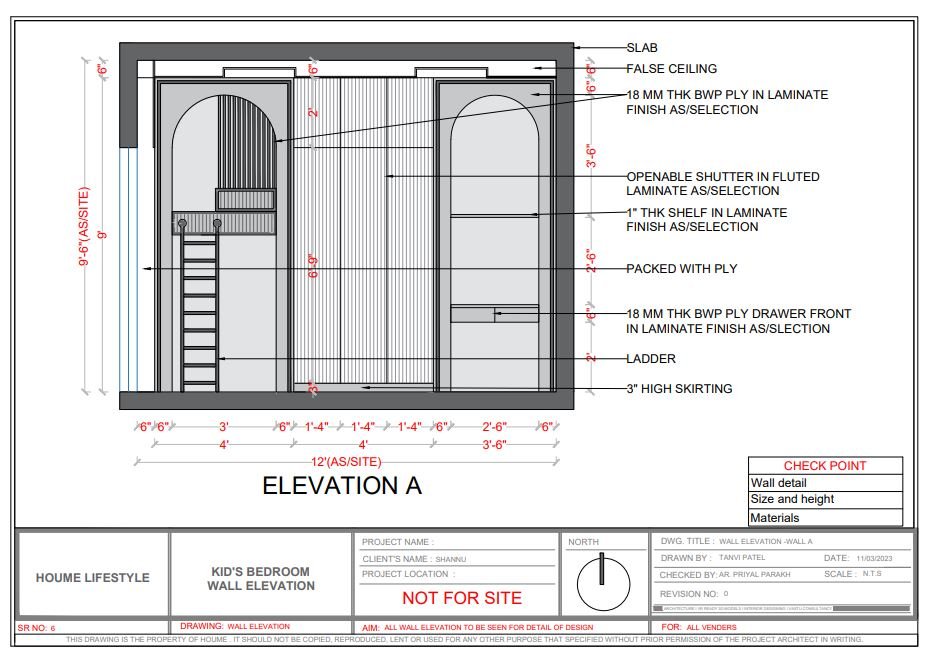

Designing a spacious and functional kids’ play area in a limited space can be a rewarding challenge. In this article, we’ll explore how to create an engaging play zone for children, based on a recent project. We’ll cover the key steps and considerations involved, ensuring your design is both practical and stylish.
To maximize the space, the first step was to divide an existing wall into three sections. This strategic alteration allowed for the creation of distinct areas tailored to different activities. On one side, a cozy reading nook was established, complete with ample storage for books. This provides a quiet space where children can comfortably read and store their favorite books.

The other side of the wall was transformed into an exciting play area. Using mild steel (MS) for the structure, we created cozy corners both above and below. These spaces are perfect for climbing, playing, sketching, and fully utilizing the available area. The design encourages kids to engage in various activities, fostering creativity and physical activity.
To unify the reading and play areas, we implemented a water-themed element that also serves as storage. This clever integration not only connects the two zones seamlessly but also adds a cohesive aesthetic to the overall design.


Given that the space was designed for children, the furniture was kept minimalistic and luxurious by opting for white hues. This choice creates a clean, modern look while maintaining a sense of elegance. Additionally, to keep costs down, we avoided expensive materials and instead used fluted laminate. This decision ensured that the design remained affordable without compromising on style.
An interesting aspect of this design is its adaptability to small spaces. The entire play area can be created within just 10 feet of wall space. For those interested in replicating this design, a detailed PDF is available upon request. Simply comment “design” to receive the complete design PDF.
By following these steps, you can create a dynamic and inviting play area for kids, even in a compact space. This thoughtful approach ensures that every inch is utilized effectively, resulting in a multifunctional and appealing environment for children to enjoy.


Creating a functional and fun play area in a small space requires creativity and strategic planning. Here are some additional tips to ensure your design is both efficient and enjoyable for kids:
When floor space is limited, think vertically. Incorporate shelves, climbing walls, or hanging storage solutions to maximize the use of vertical space. This not only frees up floor space but also adds an element of adventure and exploration for kids.
Opt for multi-purpose furniture pieces that can serve multiple functions. For example, a bench with built-in storage or a foldable table can provide both seating and additional space for activities. Convertible furniture helps in keeping the area organized and clutter-free.
Interactive elements like chalkboard walls, magnetic boards, or whiteboards can stimulate creativity and provide endless entertainment. These features can be easily integrated into the design without taking up much space, offering kids a platform to express themselves and engage in imaginative play.
Create cozy corners with soft furnishings such as bean bags, cushions, and rugs. These spaces can be used for reading, relaxing, or simply unwinding. Soft furnishings make the play area comfortable and inviting, encouraging kids to spend more time in the space.
Ensure that the play area is safe for children by using non-toxic materials, securing heavy furniture to the walls, and covering sharp edges. Safety should always be a top priority, especially in spaces designed for kids.
Add personal touches to the play area by incorporating elements that reflect your child’s interests and personality. Whether it’s their favorite colors, characters, or hobbies, personalizing the space makes it more enjoyable and special for them.
As children grow, their interests and needs change. Regularly update the play area to keep it relevant and engaging. Simple changes like rotating toys, adding new books, or updating artwork can keep the space fresh and exciting.
Designing a kids’ play area in a small space is all about maximizing every inch while keeping it fun, functional, and safe. By breaking down walls, utilizing vertical space, and incorporating multi-purpose furniture and interactive elements, you can create a dynamic environment that encourages play and creativity. Remember to personalize the space to reflect your child’s unique interests and to update it regularly to keep it engaging. With thoughtful planning and creative solutions, even the smallest spaces can become a haven for big fun and learning.
If you’re inspired by this design and want to create a similar play area in your home, don’t hesitate to comment “design” to receive the complete design PDF. This guide will provide you with all the details you need to bring this innovative and space-saving play area to life. Happy designing!